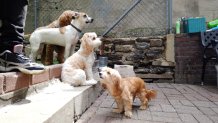Americans share their homes with 163 million dogs and cats that are walked, bathed, groomed and fed. After gobbling their treats and meat — pet food is heavy in protein — those 78 million dogs and 86 million cats poop and pee.
They produce as much trash as 90 million Americans and that doesn’t even account for the dog waste bags and cat littler.
“If American dogs and cats were their own country, they’d be the fifth largest meat consumer in the world after Russia, Brazil, the U.S. and China,” said Greg Okin, the author of a frequently cited 2017 study on the environmental impact of their diets and a professor in the Institute of the Environment and Sustainability at the University of California, Los Angeles.
What else do our often pampered pets mean for the environment? Their waste adds nitrogen and phosphorus to the soil, which in excess can reduce biodiversity. And their food production releases methane and nitrous oxide, two powerful greenhouse gases, into the atmosphere.

As climate change threatens our world, how we live is being scrutinized ever more closely, even our relationship with our dogs and cats. The Environmental Protection Agency estimates that agriculture accounted for about 11% of U.S. greenhouse gas emissions in 2020. The diets of dogs and cats account for a quarter of the environmental impact of raising livestock, in terms of the use of land, water, fossil fuels and other factors, Okin says.
Cats are particularly problematic. They are what are called obligate carnivores, meaning they are designed to eat meat, not plants. Dr. Donna Solomon, the founder of the Animal Medical Center of Chicago, recommends on her blog the average healthy adult cat get more than 50% of its daily calories from protein, at least 30% from fat and only 10% from carbohydrates. They do not have sufficient amounts of digestive enzymes necessary to process raw vegetables and fruit.
An ideal diet for a cat she says on the blog: five to six mice a day. They’re comprised of 48% protein.
Dogs, on the other hand, are not strict carnivores. Meat accounts for the majority of their diet but they can get nutrients from grains, fruits and vegetables. Those provide essential vitamins, minerals and fiber, according to the American Kennel Club.
“Dogs have been evolving with us for the last 15,000 years, and their diet has evolved very much like our diets,” Okin said. “They really are omnivores.”
At the Pet Friendly Dog Bakery in Philadelphia, Steph Johnson sells shortbread treats made from peanut butter and cannolis topped with carob. She’s as proud of the bakery’s jerky — beef, turkey and chicken.
“The gentleman who makes that for us tries to source animals from local farms as much as possible,” Johnson said.

As ecologically friendly the jerky might be in terms of its sourcing, animal based protein takes a toll. Okin estimates that livestock associated with dogs and cats adds about 64 millions tons of CO2-equivalent greenhouse gases to the atmosphere, mostly methane and nitrous oxide.
One possibility for reducing the environmental reduce is changing the source of the protein. In 2021, the pet food divisions of Mars and Nestle pet food began selling dog and cat food that included insect protein.
Then there is the poop. Waste from dogs and cats poop, if it were all thrown into the trash, would rival the production of the state of Massachusetts, Okin said.
Some dog owners are mindful of their pets' effect on the environment. In Harlem, New York, Skyla Choi is a client of Brian Taylor’s Harlem Doggie Day Spa.
“We have a biodegradable, and made of wood chips, pee-pee and poopie pad,” she said.

Taylor created a “No Poop Left Behind” campaign to encourage dog owners to clean up after their pets after residents showed up at a community meeting complaining of waste left behind on the sidewalks and in parks. Dog poop can pollute waterways with fecal coliform bacteria. A new study from Belgium found that their waste was adding nitrogen and phosphorous to the soil.
“The way to solve this problem is to give them access to poop bags,” Taylor said.
But those bags can present another problem. Even the ones that are compostable need specific levels of oxygen, water and heat to degrade that are found in municipal and commercial composting sites but not landfills. The Federal Trade Commission has warned the sellers of dog waste bags that the terms compostable and biodegradable may be deceptive.
California has prohibited the sale of plastic bags labeled “biodegradable,” “degradable” or “decomposable” unless they meet certain standards and forbids sellers from implying the bag will break down in a landfill.
One solution: Putting the poop into the toilet, Okin said. Systems are designed for toxic waste, he said, and Rockville, Maryland, for example, encourages pet owners to flush their pet waste.
Another is composting pet waste. In Alaska, Denali National Park began composting the poop from its sled dogs in 1980 for use on flowerbeds and gardens in the area. The dogs in the kennels produce up to 50 pounds of waste a day, the same weight as some of the dogs, it notes.
“We are reducing the need for fertilizers and pesticides, cutting out the need for big trucks to transport all that poo, and making our park even more beautiful,” the park's website reads.
The Fairbanks Soil and Water Conservation District in Alaska studied composting in 1991, a cooperative study that included mushers. It found that composting dog waste provided an excellent source of organic matter to add to gardens and lawns but cautioned against using it on crops grown for human consumption. Studies are examining whether that practice can be safe.
The American Kennel Club offers a guide to composting your own dog’s poop. The compost has little to no odor and provided your dog receives regular veterinary care, the risk from common parasites in minimal, it says.

The Enviro Pet Waste Network keeps track of community programs for composting dog poop across the country. In Massachusetts, Nantucket accepts un-bagged pet waste with other compostables, while Battery Park City at the tip of Manhattan is using composted dog waste collected at its dog runs for municipal landscaping. Colorado has one of the first industrial pet waste compositing facilities, according to Melissa Bauer, the sustainability director of the Pet Sustainability Coalition.
She said she sees a lot of investment in sustainability in the care of pets.
“These animals who we love so much if we’re not taking care of them responsibly can have significant environmental impacts,” she said.

